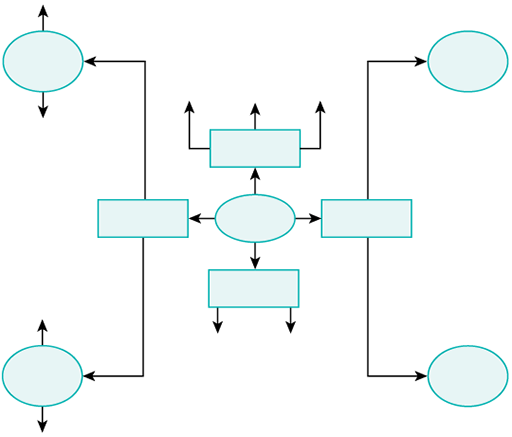1 Reflecting on culture
The term ‘culture’ carries many different meanings and is understood in different ways. In this activity you’ll reflect on what culture means to you, and then you’ll relate your understanding of the concept to definitions used within the social sciences. As you’ll find out later, our understanding of culture has important implications for the way in which we approach intercultural encounters.
Activity 2
Part 1
Let’s unpack the incredibly broad term that is culture. Imagine someone asked you what your culture was. What would you answer? What is your culture made of? Does it include your nationality, a language, a sport? Draw a mind map like the one below on a piece of paper with examples of your culture, and once you have done so, try to summarise your understanding of the term ‘culture’ in two sentences, in the box below. You can click ‘reveal answer’ for an example of a completed mind map if you need any inspiration. Your answer should, and will look different – there are no right or wrong answers here.
How would you summarise the term ‘culture’ based on your mind map?
Part 2
Now, read suggestions by academic scholars on how to define the term ‘culture’. The following two quotes are from academics who study the impact of culture on the workplace. Each quote is followed by a little more information on these authors.
‘Culture is the collective programming of the mind which distinguishes members of one group or category of people from another.’
Geert Hofstede is one of the most famous scholars in the field of Intercultural Communication. He and his research team conducted a global study with thousands of IBM employees, and developed the ‘Cultural Dimensions Model’, which identified systematic differences between almost all national cultures in the world.
‘Culture is a fuzzy set of basic assumptions and values, orientations to life, beliefs, policies, procedures and behavioural conventions that are shared by a group of people, and that influence (but do not determine) each member’s behaviour and his/her interpretations of the “meaning” of other people’s behaviour.’
Helen Spencer-Oatey is a highly influential scholar in Applied Linguistics and Intercultural Communication. She is based in the United Kingdom and has published books on intercultural politeness, global leadership and intercultural interactions.
Part 3
Now compare these quotes with your own definitions. Answer the following questions:
What aspects of culture do these quotes highlight that you might have not considered in your definition from Part 1?
Which aspects of the authors’ definitions have you also come up with in your own summary?
Part 4
Lastly, there are some fundamental differences in the two definitions you were just shown. These differences represent the two dominant views of what culture is. Finish the sentences below to establish what these differences are.
Now you have shared your thoughts on the differences, please click ‘discussion’ to reveal more on the scholars’ definitions.
Discussion
Geert Hofstede puts an emphasis on the divisive nature of categories emerging from studying culture. He assumes that there are clear characteristics that all members of a group share, which distinguish them from other groups. It is also assumed that culture determines the way a group member acts, and thereby takes away the agency of the individual. Spencer-Oatey acknowledges the complexity of the notion of culture and treats the boundaries of factors that are shared by a group as fluid. She also places more emphasis on people’s behaviour and their view of the world, thereby bestowing an individual with agency.
These two quotes represent two different schools of thought: positivism and constructivism. Hofstede is one of the most famous scholars to apply a positivist worldview and positivist research methods to the study of culture. This approach is highly influential in the fields of Management and Business, but is also controversial, as culture is usually equated with nationality and groups are assumed to be homogeneous. Constructivist approaches assume that culture is both dynamic and stable, multiple and complex, and it is ‘constructed’ through interactions with others, treating nationality as one of many variations of culture. Do not worry if this distinction does not make much sense to you just yet. By the end of the course this will be much clearer.


